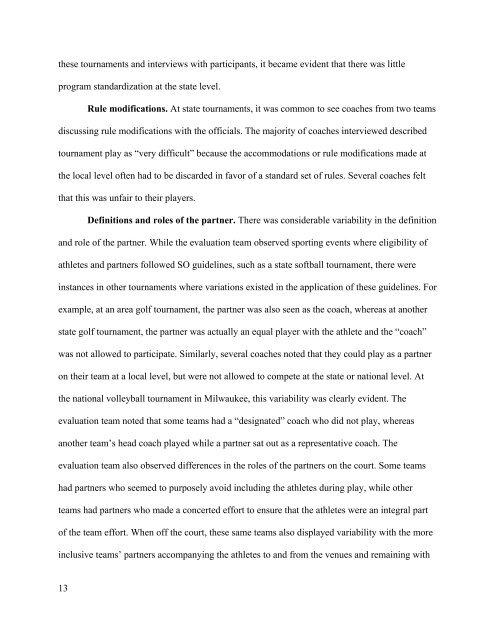Unified sports Report - Special Olympics
Unified sports Report - Special Olympics
Unified sports Report - Special Olympics
Create successful ePaper yourself
Turn your PDF publications into a flip-book with our unique Google optimized e-Paper software.
these tournaments and interviews with participants, it became evident that there was little<br />
program standardization at the state level.<br />
13<br />
Rule modifications. At state tournaments, it was common to see coaches from two teams<br />
discussing rule modifications with the officials. The majority of coaches interviewed described<br />
tournament play as “very difficult” because the accommodations or rule modifications made at<br />
the local level often had to be discarded in favor of a standard set of rules. Several coaches felt<br />
that this was unfair to their players.<br />
Definitions and roles of the partner. There was considerable variability in the definition<br />
and role of the partner. While the evaluation team observed sporting events where eligibility of<br />
athletes and partners followed SO guidelines, such as a state softball tournament, there were<br />
instances in other tournaments where variations existed in the application of these guidelines. For<br />
example, at an area golf tournament, the partner was also seen as the coach, whereas at another<br />
state golf tournament, the partner was actually an equal player with the athlete and the “coach”<br />
was not allowed to participate. Similarly, several coaches noted that they could play as a partner<br />
on their team at a local level, but were not allowed to compete at the state or national level. At<br />
the national volleyball tournament in Milwaukee, this variability was clearly evident. The<br />
evaluation team noted that some teams had a “designated” coach who did not play, whereas<br />
another team’s head coach played while a partner sat out as a representative coach. The<br />
evaluation team also observed differences in the roles of the partners on the court. Some teams<br />
had partners who seemed to purposely avoid including the athletes during play, while other<br />
teams had partners who made a concerted effort to ensure that the athletes were an integral part<br />
of the team effort. When off the court, these same teams also displayed variability with the more<br />
inclusive teams’ partners accompanying the athletes to and from the venues and remaining with

















